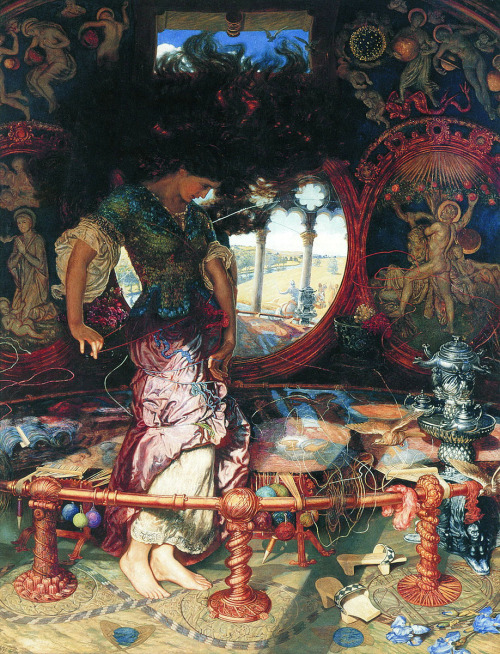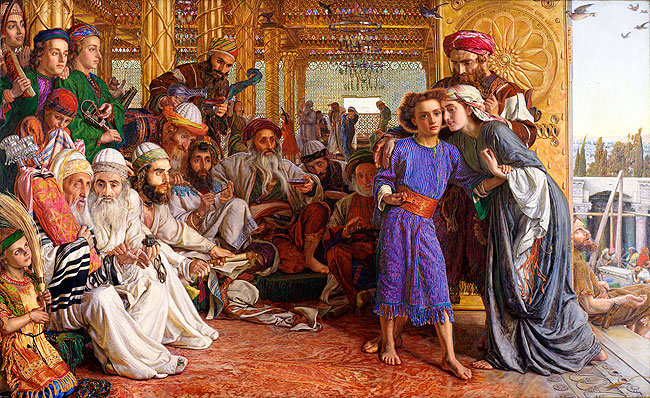
by 威廉·霍尔曼·汉特(William Holman Hunt 1829-1896)
汉 特生于伦敦,少年时代曾有一段时间当事务员。1844年进入皇家美术学院,开始画家生活。1848年和米雷及罗塞蒂组织“拉斐尔前派”,表明对十五世纪意 大利绘画的共感。在绘画手法上,标榜朴素非技巧的写实主义。主题不受因袭的束缚,以真挚的宗教性和道德性为最主要的选择标准。他自认是拉斐理论的指导者。 晚年所著的自传就此成为有关此派的重要文献。他作品的主题以精神和写实主义技法共存,成为象征注意绘画的一个典型。
About the artwork (National Museums Liverpool)
William Holman Hunt, along with other members of the Pre-Raphaelite Brotherhoodsuch as Millais and Rossetti, is well represented in the Lady Lever Art Gallery,Sudley House and the Walker Art Gallery. This is thanks to both the support of local art collectors in Liverpool and the Liverpool Academy. The Academy was responsible for the Liverpool Autumn Exhibitions. In the 1850s artist members of the Liverpool Academy decided to award prizes mainly to artists of the Pre-Raphaelite Brotherhood and in 1851 Hunt won the prize for the work 'Valentine rescuing Sylvia from Proteus'
 Valentine rescuing Sylvia from Proteus
Valentine rescuing Sylvia from Proteus
The ceremony's purpose was the greeting of the sun on May morning from a high place and derived from Druidical worship. Antony Wood first recorded the ritual: "the choral ministers of Magdalen Colleges do, according to ancient custom, salute Flora every year on the first of May, at four o'clock in the morning, with vocal music of several parts which, having been sometimes well performed, hath given greater satisfaction to the neighbourhood and auditors below ".
The ceremony was to become redundant but was revived in 1840 by Dr JR Bloxam who introduced 17th century hymn and organ music for it. He is featured prominently, (the man with the black robe in the painting), amongst the row of Fellows. The president of the College, Sir Herbert Warren is the younger man with the beard. Other known members of the College include the organist and choir singers. The most intriguing figure is that of the Parsee, a worshipper of sun, in reality a merchant from the Indian Institute in Oxford. Hunt drew from the pagan origins of the May morning ceremony, distinct in this work, for the emphasis on the spiritual. Hunt included the sun worshipper to suggest that all religions serve a common spiritual purpose. This fusion of various traditions was perhaps too confusing and progressive for Victorian society and it is no surprise that the painting remained unsold. Lord Leverhulme bought it from Hunt's widow in 1919.
Hunt was born in London and demonstrated an early talent for painting. However, he was forced to work as a clerk in the City by his father. He managed to take up painting at the age of sixteen and registered as a student at the Royal Academy in 1844. While still a student Hunt read John Ruskin's 'Modern Painters' in 1847 and became influenced by the idea of a moral purpose for art. Ruskin also encouraged artists to carefully study nature and Hunt embraced this practice. Hunt's style is easily distinguished from other Pre-Raphaelite painters by the emotional intensity of his characters and his choice of mainly religious and moral subjects. The Lady (Lever Art Gallery) has some of the best examples.
The Lady
In 1854 Hunt travelled in the Near East, keen to expand his religious experiences and encounter new artistic challenges. From Cairo he moved to Jaffa, before settling in Jerusalem until 1855. From Jerusalem he travelled to Nazareth, Damascus and Beirut. He returned to England in 1856. Throughout his travels Hunt made numerous sketches and studies of local people and the landscape. Hunt revisited Jerusalem between 1869 and 1872. His last visit to Jerusalem was in 1892. Hunt's fascination with the Middle East distinguished him from the rest of the Pre-Raphaelite artists. Especially after his travels there, Hunt's work won critical acclaim amongst private dealers rather than at the Royal Academy exhibitions. As early as 1860 Hunt sold 'The Finding of the Saviour in the Temple' (now at Birmingham Museum and Art Gallery) to the dealer Ernest Gambart for the amazing sum of £5,500.

The Finding of the Saviour in the Temple
The Painting
Hunt attended the May Morning ceremony and made initial observations about it in 1888. The Walker Art Gallery has a watercolour study of the details of the tower, which Hunt studied for several weeks. For the figures in the painting he chose people from St. Magdalen College but also used the choir of Westminster Abbey. Not only did Hunt have problems with the choice of models but he also realised that the ceremony was not popular with people outside the Magdalen College, as he confessed in a letter to his wife after his second stay in Oxford in December 1888. The vivid and individual expressions of all the figures suggest that they were all modelled from the choir as well as members of the College. The youth of the boys reflects the fertility and blossoming of nature during May. The young boy looking directly out at us is holding a lily, the symbol for St Mary the Virgin and St Mary Magdalen to whom the College was dedicated.
Hunt was not really concerned with an accurate depiction of the ceremony and that is why he does not include the people attending or a proper view from the tower. In a letter to the 'Pall Mall Gazette' Hunt commented that he wished the painting: "to represent the spirit of a beautiful, primitive and in a large sense eternal service, which has only been in part restored on the tower, even to the floral fullness of three centuries since, but which still carries evidence in it of the origin of our race and thoughts in the same cradle with the early Persians. This was the kernel of the scene which I had to extract "